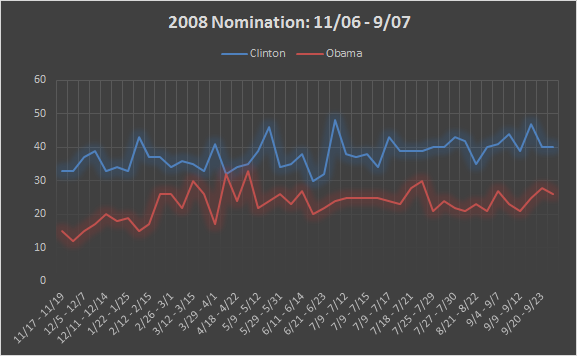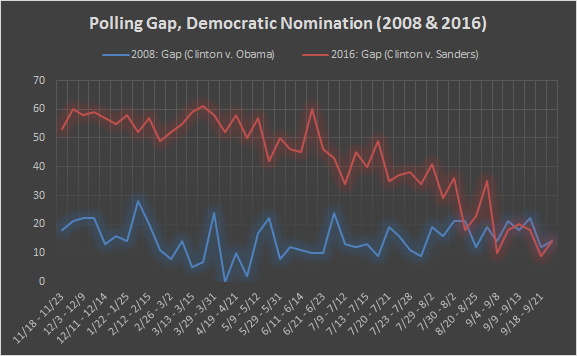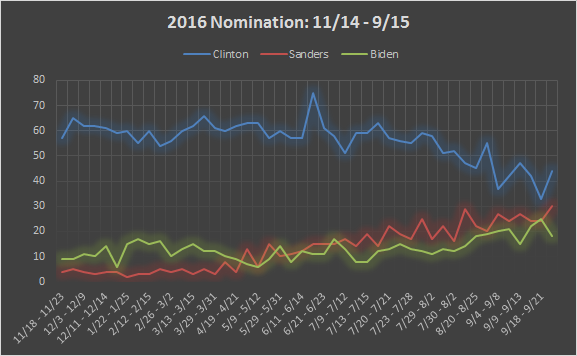It’s safe to say that this election has so far been nothing short of a doozy. Few people, I believe, could have predicted the success that Donald Trump would have had in maintaining a grasp on the right leaning media, and hurl himself into existence, persistence, and resistance that has since become the Republican Party.. Expectations of who would be the next president were ultimately shattered into tiny bits and pieces with the campaign of Scott Walker taking a hiatus, and yet the theory still persists with respect to who will be the next Republican Presidential Nominee. The theory goes, that it’ll be a showdown between an establishment candidate versus someone that is outside. Trump, for sure, is outside of the mainstream (or representing the grass roots), but is he too outside of the proverbial box? Probably. Regardless, Paul Waldman over at the Washington Post thinks that it may be a contest between Rubio and Bush, which isn’t too implausible given his explanation. That having all been said, I would suggest also that the grass roots vs. establishment showdown wont just be a matter relevant to the Republican Party. It would be unwise to discount the fact that Sanders is a model example of grass roots vs. the establishment, i.e., Clinton. Even if Biden were to announce a legitimate run for the oval office, the same trend follows. And say what you will about Trump, he truly is a mixed bag of opinions and gaffes, but that mixture is broad.
While I would certainly agree with my friend and colleague over at Nerd Union that it’s probably way too early to tell, I do want to make a few points about the Democratic side of things. I decided to take a gander at the polling data, and for reasons beyond my scope of understanding, I decided to compare the 2008 election to the current one now. Despite the mainstream’s unending fascination with the mainstream candidates, Sanders is doing spectacularly.
Here’s some information for you, between November 2006, and the end of September 2007, Hillary Clinton had gained 7 points, and Obama 11 in the polling data, and their gap was at a 14 point difference with Clinton in the lead (40 to 26). But fast forward 7 years, and there’s a bit of a different picture. Clinton started off strong, because the Democratic Party all but went ahead and gave her the nomination, and started off at between 57 and 65%, whereas Bernie Sanders sat at about 4%, and Biden 9%. But here’s the crazy thing – Sanders has gained 26 points, and Clinton has lost 13 points. Despite the media’s insistence on how great Joe Biden is doing for having “nearly doubled” in the polls, Sanders has almost quadrupled. Moreover, Biden’s polling has really oscillated between the 9% up to 15%, back to the 9%, and has only just recently entered the 20% range. And while Biden may have reached 18%, which is indeed a doubling of initial polling data, it’s a 7 point drop from the last data point. Sanders, on the other hand, increased by 6 points. The biggest take away from all of this is to say that Bernie Sanders, in a period of four months, has almost quadrupled in current polls, and essentially placed himself in the same place that Obama was at, at around the same time during the 2008 election.
Below are some graphs for your eyes to munch on. The first graph shows the 2008 election for the selected time frame, that being between November 2014 to September 2007. What you see is that Obama and Clinton essentially maintain their respective places in the polls.

This next graph shows the main point of this post. These data show that Sanders is catching up, and is by and large on the same election footing that Obama held at about the same time during his 2008 bid. The graph shows the gap. Near the end of September back in 2007, Clinton held a 14 point lead over Obama nationally. Currently, Clinton holds a 14 point lead over Sanders, at about the same point during this election. What I find so neat about the Sanders campaign is the relative swiftness in his rise in the polling data.

This last graph shows the national polling data between November 2014 to September 2015 for Clinton, Sanders, and Biden. As you can see, Clinton has taken a huge dive in the polls (-13 points than when she started), and Sanders has risen a great deal. To make the point even more profound, Sanders started lower than the prospective bid that Biden has yet to officiate, and has relatively quickly taken and maintained that lead.

Having said all of this, I am not making a clear prediction* in terms of who will be the next Democratic nominee. Fact remains that the media is heavily focused on Clinton’s emails, and a prospective Biden bid, that they don’t spend a lot of time focusing on Sanders – which, in my opinion, makes Sanders’ success all that more fun to watch. More importantly, though, is this caveat – this is a small four month window of comparison, and as I have stated above, this election has been a doozy. There are at least eight more months of polling data, and the first caucus, which is in Iowa, is on February 1st – or five months away. A lot can happen between now and then.
But before I end this post, a brief mention about those caucuses. During this time in the polling for the 2008 election, Hillary was projected to win the Iowa caucus, as she maintained a 6 point lead over Obama. Currently, polling shows that Clinton leads Sanders by 22 points for the Iowa caucus, but the averages show that she’s only 5.2 points ahead (Sanders 33.3, and Clinton 38.5). At this point during the 2008 election, Clinton was 6 points ahead, but also had an average of a 5 point lead (Obama 19.2, Clinton 24.2).
As for New Hampshire, in 2008 Clinton held a 19 point lead during the September polling, and won by only 2. As for the current election, Clinton maintained a lead up until the beginning of August, where he’s gathered an average of 10.5 point lead over Clinton.
Having shared all of this great bit of information, I should reiterate the importance of not making predictions with respect to who will be the Democratic nominee, much less the next president. But it cannot go without saying that Sanders is successfully running a grass roots campaign that is not too dissimilar to that of Obama’s 2008 campaign.
*Although I have cautioned against making predictions, I will go ahead and give two and a half predictions:
1. Bernie Sanders goes on to take the lead ahead of Hillary around December or January, and goes on to win the nomination, and as such, will be a close win, far closer than Obama’s 2008 nomination;
or
2. Clinton maintains her slight lead over Sanders, and goes on to win the nomination that has already been handed to her;
.5 Biden remains stagnant in the polls, irrespective of any official campaign. Why? Because he isn’t doing well now, and he didn’t do well during his last attempt.



